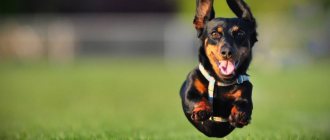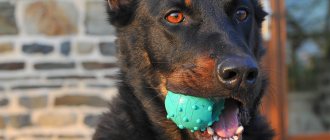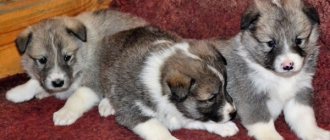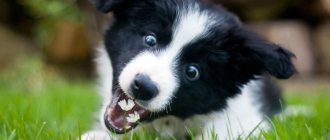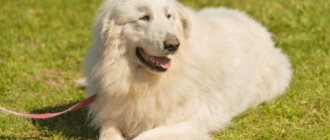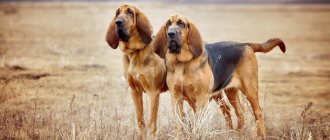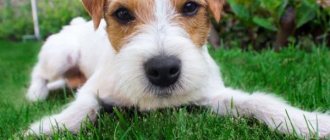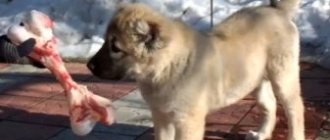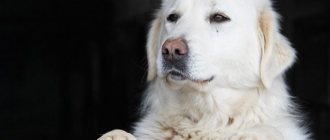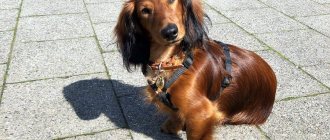Origin story
The time and place of appearance of the first representatives of the species has not yet been established. It is known that the earliest drawings depicting similar animals were found in Egypt.
Representatives of the modern Dachshund breed were bred in Southern Germany in the 16th century for burrow hunting of badgers. Therefore, the second name of this species is Badger Dog.
Short, strong legs and a long body allow these hunters to penetrate rodent burrows, and the Dachshund's strong paws and teeth quickly deal with the enemy.
Having become quite popular among German hunters, this breed multiplied and divided into varieties.
Therefore, breed standards were established in 1870. Subsequently, in 2001, the FCI International Organization finally adopted the standard characteristics of the Dachshund.
It appeared in Russia relatively recently and has gained popularity among hunters and the elite of Russian society.
Variegated and colorful
Dachshund dogs are divided not only by size, but also by coat type:
- Smooth-haired
- Longhair
- Wirehaired
The primary type of dachshund is smooth-haired, which is distinguished by short, shiny hair, very thick and close to the body. Long hair on the tail and feathering on the inside of the tail are acceptable.
Long-haired dachshunds were bred by crossing with spaniels and are characterized by a soft, shiny coat that is at least 5 cm long. There is a thick undercoat and feathering on the belly, paws and tail.
The thick, fluffy cover on the face is especially pronounced, and the hair on the ears and tail, on the contrary, is short and smooth.
There are three types of color: one-color, two-color and spotted.
In the single-color version, all shades from fawn to chocolate are acceptable, and the more intense the color, the more thoroughbred the dog.
The two-tone color is a dark, black or brown coat with red or light tan.
- The most popular dog names in alphabetical order with recommendations
Shar Pei - history of the breed, character traits, care and possible problems + 87 photos
- American Bulldog - history of the breed, appearance, specifics and characteristics, care (100 photos + video)
There are two types of dachshund spotting: marbled or brindle. In the first case, small light markings stand out on black, gray or red fur.
The brindle coloring resembles the skin of a predator: clear contrasting dark brown stripes on red-red or fawn fur.
Types by appearance
Based on external features, they are divided into types:
Note!
Nicknames for dogs for boys - easy, rare and most beautiful names for dogs in alphabetical order
- Nicknames for girls' dogs - a list of beautiful, funny, unusual nicknames for large and small dog breeds
Maltipoo dog - everything about the dog from A to Z. Photos, description of the breed, character, maintenance features, prices, reviews
Standard – widespread. Body weight - about 9 kg. Chest circumference - 35 cm or more.
Dwarf. Body weight – up to 7 kg. Bust circumference – 30-35 cm.
Rabbit. Body weight – up to 4 kg. Chest circumference – up to 30 cm.
Height at withers – from 12 cm to 30 cm, respectively. Belonging to any of the species is judged by chest girth.
Briefly about the breed
The Dachshund is a short-legged, muscular and squat dog whose size is based on proportions. Thus, the body length of a thoroughbred animal should be 1.7 to 1 to its height, and the distance from the bottom of the chest to the support should be 1/3 of the height.
Different types of breeds, long bred for hunting animals of different sizes, have their own dimensions:The standard type of dog is the largest and most versatile, used for burrow hunting and chasing large animals. Its dimensions are characterized by a height of about 35 cm, a sternum girth of more than 30 cm and a weight of up to 9 kg.
Miniature or dwarf dachshunds occupy a middle position, with a height and rib girth of up to 35 cm, and a weight of 3 to 4 kg. Dwarfs were bred from the stockiest animals of the standard species.
The shortest among the dachshunds is called the rabbit dachshund and is 5 cm shorter than its average counterpart in height and 1 kg less in weight.To obtain a more compact and nimble hound, the dog was crossed with pinschers and toy terriers and used in hunting hares and rabbits.
The standards also spell out body features: a wedge-shaped head, a flat, wide forehead and a flattened nose, oval eyes of dark brown and lightened shades, ears broken in the lower third, a long neck and a saber-shaped low tail.
Maintenance rules and care
The Dachshund is a temperamental and sociable dog. She gets along well with children, but does not tolerate competition. This is a person with character who needs to be given enough attention.
Dachshund puppies are very active and curious. Before they appear in the house, you should remove all dangerous and valuable objects away.
If you don't raise your Dachshund puppy in time, he will become uncontrollable. Thanks to its bloody hunting disposition, this dog has all the qualities of a warrior: courage, agility, loyalty and stubbornness. This must be taken into account when purchasing it.
Proper nutrition and exercise are of great importance for the health and development of your pet.
Proper feeding
You can feed your dog natural or dry ready-made food. Her diet should include the following foods:
- meat and fish,
- cereals and cottage cheese,
- milk porridges, etc.
But whole milk should not be given to your pet, as it is not absorbed by his body.
It's important not to overdo it. The Dachshund's appetite is good, but the structure of its body requires dietary restrictions. These dogs are prone to obesity, which leads to severe stress on the spine and even paralysis.
Therefore, it is necessary to control her weight. At the slightest suspicion, a diet and consultation with a specialist is necessary.
Mobility
Walking is very important for the health of the animal. They help prevent excess weight gain.
In addition, this is an opportunity to communicate with the outside world and with the owner. Dachshunds love to run fast, but they should not be allowed to jump from different heights or objects of any height.
In this case, there is a danger of displacement of the vertebrae and injury, which will lead to paralysis. Therefore, you need to carefully monitor your dog while walking.
Due to their small size, Dwarf and Rabbit Dachshunds require more care outside. Individuals of the ordinary species are not afraid of large dogs and bark very loudly. Their voice is clear and can be heard over a long distance.
In cool weather, it is better to dress smooth-haired pets in warm dog clothes. These dogs quickly become hypothermic and are prone to colds.
Advantages and disadvantages of this breed
Each breed of dog has its own positive and negative sides, this also applies to dogs of this breed, including the dwarf dachshund.
The positive aspects of this breed are intelligence, devotion and ease of maintenance. With appropriate training, this breed of dog has a certain intelligence and good manners.
Dogs of this breed have a positive attitude towards water procedures and swim without much fear in open bodies of water, as well as in bathrooms.
They are excellent guards and in the event of any illegal actions on the part of any people, they begin to bark loudly and sometimes loudly, and in some cases boldly go on the attack, despite their size.
The disadvantages of this breed include certain wayward character traits, pride and stubbornness, as well as a certain touchiness and, in some cases, vindictiveness. Some diseases characteristic of a given breed can be genetically transmitted from generation to generation.
Also, in some cases, dogs of this breed, especially smooth-haired ones, can freeze. Therefore, during the cold season, it is recommended to dress smooth-haired dachshunds in special clothing for dogs and reduce walking time in winter to a minimum.
Grooming
Smooth-haired pets do not require special care. It is enough to wipe them with a terry towel or mitten once a day.
Long-haired dogs need to be brushed with a special brush daily. Wire-haired individuals require special care.
They need to periodically remove dead hairs from their fur and trim them. This must be done manually, using scissors and a furminator. If this is not done, your pet may get a skin disease.
Adults need to be bathed once every 3-4 months. Small puppies under six months should not be bathed at all. You just need to wash your paws after a walk.
Dachshund care
Although this breed of dog does not require much care, it still needs care. You should brush your pet's teeth with special brushes. You should periodically examine the dog's eyes and remove any discharge that appears, and if signs of any eye disease begin, the animal should be shown to a veterinarian.
Periodically you need to clean your dachshund's ears with cotton swabs. You should take care of the coat, especially in long-haired breeds, periodically comb it, and bathe the dog with special products.
Smooth-haired breeds also need periodic bathing in warm water, after which the animal should be dried. If it's warm and dry outside, you can limit yourself to wiping your paws. You should monitor the claws and, if necessary, trim and file them.
Due to the characteristics of their long bodies, dogs of these breeds may experience problems with the spine, so it is necessary, for example, to limit the dog’s jumping upwards. Avoid long descents and ascents of the dog along the access stairs.
Purchasing Tips
You can buy a Dachshund puppy at the market or through an advertisement without documents. Such a purchase is not expensive, but does not guarantee the purchase of a purebred dog.
Babies with a pedigree and documented documents confirming their belonging to the breed are much more expensive.
You can find out how much Dachshund puppies cost on Avito.ru and other ad sites. Purebred individuals have a price of no less than 20 thousand rubles.
If you do not plan to breed the breed or participate in exhibitions and competitions, then inexpensive options are quite suitable.
If you have big plans, then be sure to ask the seller for documents for the mother dog and the puppy.
In addition, carefully examine the animal for diseases. The Dachshund dog is little susceptible to disease, but poor care and heredity can affect its health.
Our pets can either make or spoil our lives. Therefore, when purchasing an animal, especially a dog, you need to find more information and carefully weigh your options.
